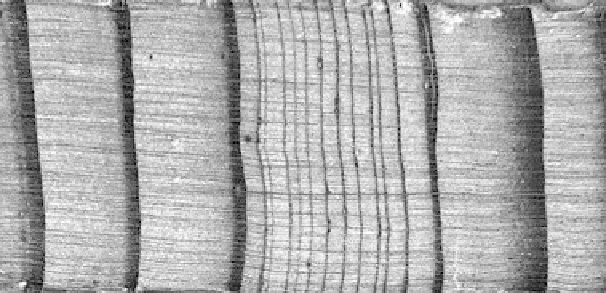Geoscience Reference
In-Depth Information
Fig. 9.5
Photograph of reduced tree-ring growth in a Douglas-fir tree due to a defoliation event by
western spruce budworm. This type of rapid and sustained growth reduction over a distinct period
of time, often followed by a growth surge, is characteristic of defoliation events, and generally is
not typical of drought responses
instrumental climate data, (3) the use of the non-host chronologies (if comparison
tests are satisfactory) to 'correct' the host chronologies (i.e., to remove most or all
of the climate effects from the host chronologies), and (4) validation of the cor-
rected chronologies with independent forest entomology records (e.g., maps and
observations of defoliation and/or insect population measurements). The correc-
tion procedure involves subtraction of a variance rescaled version of the non-host
chronology (index values) from the host chronology.
Resulting 'corrected' budworm-affected chronologies from individual trees or
stand averages can then be combined into network composites for subregions. Our
original work on this focused primarily on stand-level averages of corrected host
ring-width chronologies, and the subregional composites were expressed as 'num-
work we found that an 'epidemiological approach,' focusing more on the responses
of individual trees and their collective responses, rather than solely on stand aver-
ages, was more effective in revealing outbreak timing and magnitudes. Composites
of these data are expressed as numbers or percentages of trees (by site or in the
One of the consistent findings of our western spruce budworm studies in four sub-
regions of the western United States is a general correspondence between budworm
outbreaks and wet periods, coupled with reduced budworm outbreaks (endemic peri-
temperature variables in the southern Rocky Mountains of New Mexico, Swetnam
June) was best correlated with the regional budworm composite record. In addition
to concurrence of wet periods and outbreaks, in cross-correlation and cross-spectral
analyses we found that increased wet conditions usually preceded the outbreaks by
several years up to a decade. These findings suggest that wet conditions predispose
trees and forests to budworm outbreaks.

